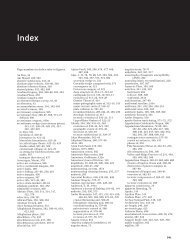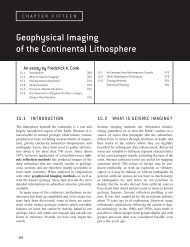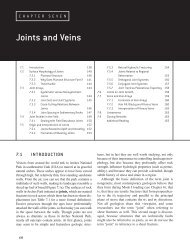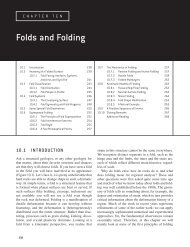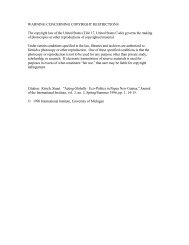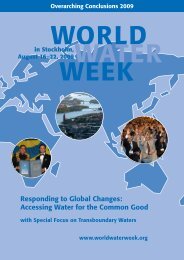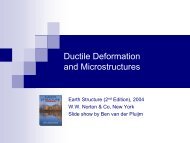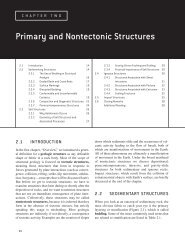750A.B. Weil et al. / Journal <strong>of</strong> Structural Geology 22 (2000) 735±756A regional fold test was done on the southern section<strong>of</strong> the Proza domain between sites SL38, SL39,SL44, SL45, SL46, <strong>an</strong>d SL82 (Fig. 14b). <strong>The</strong> beddingstrikes <strong>an</strong>d magnetic declinations in this region have958 <strong>an</strong>d 658 <strong>of</strong> variation, respectively; consequently, aMcElhinny (1964) fold test was not used. An inclination-onlyfold test yielded a maximum clustering at100% unfolding with a +188 me<strong>an</strong> inclination(kappa=26). Given that the fold test was performedon a single limb <strong>of</strong> <strong>an</strong> original pre-F 3 <strong>an</strong>ticline, whatwas actually being tested is whether F 3 folding producedthe southern Proza's undulatory inclinations<strong>an</strong>d observed curvature. Thus, the pre-folding resultfor the single limb is consistent with a B magnetizationcomponent that was acquired after F 1 <strong>an</strong>d F 2 folding,but prior to F 3 folding. <strong>The</strong> ®nal fold test was done onsites SL80 <strong>an</strong>d SL81, which are positioned in a faultpropagationfold at the terminus <strong>of</strong> the Proza's easternlimb. If, as determined above, the curvature <strong>of</strong> thesouthern portion <strong>of</strong> the Proza is related to F 3 de<strong>formation</strong>,then it follows that the large thrust that separatesthe western limb from the eastern limb isassociated with space accommodation during F 3 folding.A McElhinny (1964) fold test was performedbetween the sites resulting in a maximum kappa <strong>of</strong> 194at 80% unfolding with a me<strong>an</strong> inclination <strong>of</strong> 68(Fig. 14c). Similar to the previous fold test, this foldtest was performed on a single limb <strong>of</strong> a larger <strong>an</strong>ticlinalstructure. Thus, the pre-folding result <strong>of</strong> the foldtest reinforces the conclusion that thrusting <strong>of</strong> the westernlimb is contempor<strong>an</strong>eous with F 3 folding.Two F 3 fold axes were calculated for the southern<strong>an</strong>d middle portion <strong>of</strong> the Proza Anticline (for sitesSL38, SL41e, SL41w, SL44, SL45, <strong>an</strong>d SL46, <strong>an</strong>d forsites SL39, SL47, <strong>an</strong>d SL82) (Fig. 12b) as dictated <strong>by</strong>the undulating nature <strong>of</strong> the observed inclination trend(Fig. 13). No sites were taken from the eastern limbbecause <strong>of</strong> the large thrust fault that separates the twolimbs east <strong>an</strong>d southeast <strong>of</strong> site SL47 (see Fig. 4).Using the calculated axes, site me<strong>an</strong>s <strong>an</strong>d beddingFig. 12. Stereographic projection <strong>of</strong> Proza Anticline site me<strong>an</strong>s (largecircles) <strong>an</strong>d bedding poles (small circles), both in situ <strong>an</strong>d structurallycorrected. Open symbols represent upper hemisphere projections <strong>an</strong>dclosed symbols represent lower hemisphere projections. (a) Stereographicprojection <strong>of</strong> in-situ northern <strong>an</strong>d southern site me<strong>an</strong>s forthe Proza structural domain (large net), <strong>an</strong>d stereonet <strong>of</strong> poles to insitubedding for the entire structure (small net). (b) Southern siteme<strong>an</strong>s with best-®t small-circle (dashed in upper hemisphere <strong>an</strong>dsolid in lower hemisphere) <strong>an</strong>d result<strong>an</strong>t F 3 fold axis (black diamond).(c) Northern site me<strong>an</strong>s showing in-situ site me<strong>an</strong>s in largecircles <strong>an</strong>d vertical-axis rotated site me<strong>an</strong>s as small circles (asdescribed in text), <strong>an</strong>d result<strong>an</strong>t F 3 fold axis (unrotated F 3 fold axesrepresented <strong>by</strong> a black diamond). (d) Structurally corrected Prozasite me<strong>an</strong>s using calculated F 3 fold axes (large net), <strong>an</strong>d correctedpoles to bedding (small net). Notice the nearly north±south trend<strong>an</strong>d shallow plunge <strong>of</strong> the restored pre-F 3 Proza <strong>an</strong>ticline (fold-axisshown as black diamond).Fig. 13. Plot <strong>of</strong> inclination vs. linearized dist<strong>an</strong>ce, from north (0 km)to south (60 km), along structural strike for the east <strong>an</strong>d west limbs<strong>of</strong> the Proza Anticline. Notice the undulatory pattern imposed <strong>by</strong> F 3folding, as well as the repeated pattern <strong>of</strong> the east <strong>an</strong>d west limbtr<strong>an</strong>sects. Sites SL77, SL75, <strong>an</strong>d SL42 are excluded as discussed intext.
A.B. Weil et al. / Journal <strong>of</strong> Structural Geology 22 (2000) 735±756 751were corrected as previously explained (Fig. 12d)(see Table 2 for corrected site me<strong>an</strong>s <strong>an</strong>d rotation parameters).After correction, the southern half <strong>of</strong> theProza <strong>an</strong>ticline tr<strong>an</strong>sforms from <strong>an</strong> amphitheater geometryto <strong>an</strong> almost linear north±south-trending westdippingfold, similar to the proposed reconstruction <strong>of</strong>the Lagos del Valle Syncline to the west (V<strong>an</strong> der Vooet al., 1997).A similar approach was used for the northern siteme<strong>an</strong>s on both the west <strong>an</strong>d east limbs <strong>of</strong> the Prozastructure. Two families <strong>of</strong> site me<strong>an</strong>s were distinguished<strong>by</strong> inclination patterns, sites SL43, SL72, SL73<strong>an</strong>d SL79 to the north, <strong>an</strong>d sites SL40, SL48, SL74,SL76 <strong>an</strong>d SL78 immediately to the south (Fig. 12c).Three sites in the northern area were not used forstructural <strong>an</strong>alysis for the following reasons: (1) SL77did not provide a stable direction, (2) SL75 wassampled in Carboniferous limestones, <strong>an</strong>d (3) SL42gave <strong>an</strong> <strong>an</strong>omalous direction. All <strong>of</strong> the northern sites<strong>of</strong> the Proza domain have experienced clockwise verticalaxis rotation, which c<strong>an</strong> be seen in the south tosouthwesterly directions <strong>of</strong> the site me<strong>an</strong>s <strong>an</strong>d thenortheasterly trend <strong>of</strong> in-situ bedding, but they alsounderwent tilting, which c<strong>an</strong> be seen in the inclinationpattern (Fig. 13, Table 1). In order to correct properlyfor F 3 de<strong>formation</strong>, a small-circle was calculated forFig. 14. Local incremental <strong>an</strong>d inclination-only fold tests for the Proza Anticline. (a) A local incremental fold test <strong>of</strong> sites SL41e <strong>an</strong>d SL41w plottingkappa (squares) <strong>an</strong>d CR (tri<strong>an</strong>gles) vs. percent unfolding. <strong>The</strong> CR parameter is the critical ratio above which the kappa values become signi®c<strong>an</strong>tat the 95% con®dence level. <strong>The</strong> maximum kappa value <strong>of</strong> 40 at 0% unfolding shows a B component acquired post-folding to F 1 <strong>an</strong>dF 2 . (b) An inclination-only test <strong>of</strong> the southern Proza's western limb, plotting kappa (squares) <strong>an</strong>d inclination (diamonds) vs. percent unfolding.<strong>The</strong> test yields a maximum kappa value at 100% unfolding. Because all site locations are located on the western limb, this result suggests that F 3de<strong>formation</strong> post-dates magnetization acquisition. (c) Incremental fold test between sites SL80 <strong>an</strong>d SL81 in the southern terminus <strong>of</strong> the Proza'seastern limb. <strong>The</strong> maximum kappa value is reached at 80% unfolding, consistent with the interpretation that this fold is <strong>an</strong> F 3 structure relatedto thrusting <strong>of</strong> the Proza's western limb over the Proza's eastern limb.



